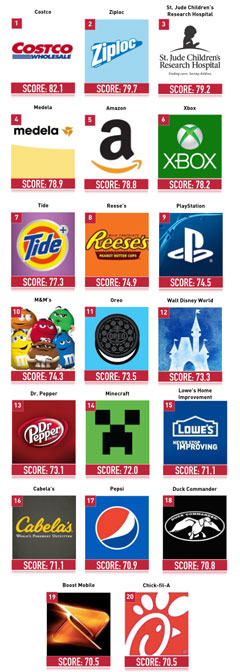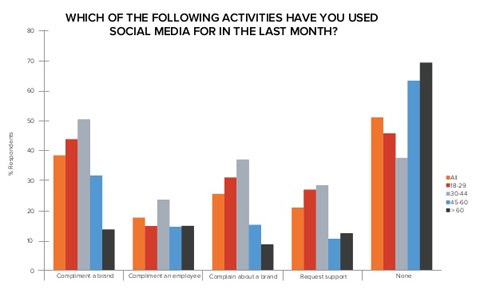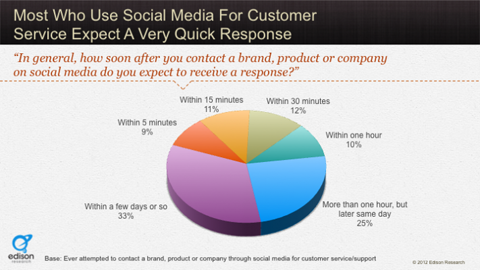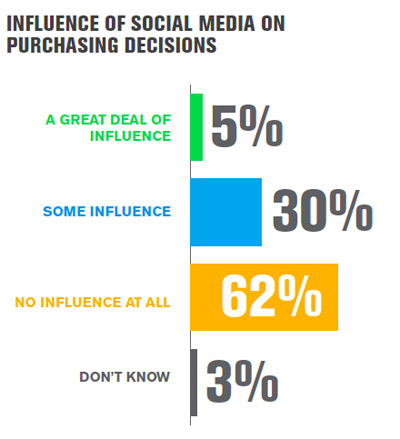 Are you wondering what consumers expect from brands when it comes to social media?
Are you wondering what consumers expect from brands when it comes to social media?
A series of new reports answers this very question.
Consumers have strong expectations for how brands use social channels.
In this article, you'll discover findings from studies to help you determine what consumers want to see from you on social media.

#1: You Better Be on Facebook!
Inbound marketing leader HubSpot asked 569 customers what social media presence they expect of any brand. In The Social Lifecycle: Consumer Insights to Improve Your Business, consumers report they expect brands to be active on at least three to four social channels.

Specifically, 95% of Millennials expect brands to have a Facebook presence. Also, 87% of Gen X'ers (30- to 44-year-olds) and even 70% of those ages 45 to 60 think brands should, at the very least, have a Facebook page. While consumers reduced expectations by about 10% for Twitter presence, they dropped expectations even further for Instagram, LinkedIn, Pinterest, YouTube and Google+. Only about 50% of those polled expect brands to have a presence on these social media platforms.

Key Takeaways
Social channels are a sign of a company's dedication to transparency, accountability and even customer service! Customers recognize this and expect to see a brand engaging with customers on Facebook. Even though “silent” customers may not add comments or likes (basically, VALUE) to a brand's Facebook page, still . . . they're watching.
Brands' social media channels leave them open to consumer criticism. American consumers know this and therefore have more respect for companies that encourage feedback and respond in a timely and thorough manner.
What do customers want from companies on Facebook?
If customers expect a brand to be active on Facebook and possibly two or three other social channels, the next question is, what do they want from companies there?
A good way to determine this is to examine which companies have the most loyal social media following. LoudDoor's August 2014 study, Top 20: Brands with the Most Loyal Fans on Facebook, gives us some insights on what motivates consumers to take time from their busy schedules to become brand advocates. Who are these “Top 20” brands and how did they make their fans so engaged?

Posts from these brands cover:
Get World-Class Marketing Training — All Year Long!
Are you facing doubt, uncertainty, or overwhelm? The Social Media Marketing Society can help.
Each month, you’ll receive training from trusted marketing experts, covering everything from AI to organic social marketing. When you join, you’ll also get immediate access to:
- A library of 100+ marketing trainings
- A community of like-minded marketers
- Monthly online community meetups
- Relevant news and trends updates
- Costco (1.2 million fans): Deals on items consumers need.
- Ziploc (1.5 million fans): Holiday recipes like cakes encrusted with peppermint sticks crushed in Ziploc bags? Crafts and holiday decorations stored in . . . you guessed it . . . Ziploc containers.
- St. Jude Children's Hospital (1.7 million fans): Photos of children getting better.
- Medela (247,000 fans): Baby photos and information to support breastfeeding.
- Tide (over 4 million Facebook fans): Featuring the Scott twins, also known as the Property Brothers. Focused on clothes that can get really dirty like military, janitorial, construction and firefighting uniforms.
- Reese's Candy Company (12 million fans): Interesting desserts incorporating Reese's products. Peanut information.
Most posts from these brands include something with the potential to enrich the reader's life. As the LoudDoor study authors explain:
People respond to things that are relevant to them. Understanding the passions and interests of your advocates guides your understanding of what interests your most passionate consumers.
Key Takeaway
When brands deliver entertainment and enrichment on social media, they are rewarded with brand advocates and consumer goodwill. In this era when brands must skip direct selling and rely on brand advocates to market for them, social media channels should only tangentially touch upon a brand's products and services; instead focusing on customers' needs.
#2: Provide Actual Support Via Social
In their 2014 State of MultiChannel Customer Service report, researchers at Parature (a Microsoft company) asked 1,000 consumers whether they ever asked a customer service question via social media. Thirty-five percent responded that they had. Of these respondents, 51% reported that the brand's response gave them a “somewhat more” or “much more” favorable view of the brand.

Discover Proven Marketing Strategies and Tips
Want to go even deeper with your marketing? Check out the Social Media Marketing Podcast! Publishing weekly since 2012, the Social Media Marketing Podcast helps you navigate the constantly changing marketing jungle, with expert interviews from marketing pros.
But don’t let the name fool you. This show is about a lot more than just social media marketing. With over 600 episodes and millions of downloads each year, this show has been a trusted source for marketers for well over a decade.

Additionally, the HubSpot report mentioned in #1 above confirms consumer reliance on social media for communication with a company.
Of the HubSpot study's 569 respondents, 50% reported they'd complimented a brand in the past 5 months, 35% complained about a brand and 30% requested support. Many populations, including those over age 60, are using social media to connect with companies to express their gratitude, get guidance or satisfaction.

In the beginning of the social media revolution, many brands resisted establishing social media channels due to a fear of negative comments. The HubSpot study finds that consumers reached out on social media to compliment a brand more often than to criticize it (50% vs. 35%).
An Edison Research study found that not only do consumers expect companies to have social media channels, they expect them to be ready to respond quickly there. Forty-two percent expect a response in under an hour, 25% in the same day and 9% want it in 5 minutes!

Key Takeaway
Smart brands leverage consumers' comments, compliments and even criticisms on social media to strengthen the brand's image. Provide an easily accessed customer service and communication channel via social media to add to a brand's credibility.
#3: Skip the Sales Posts
People do not go to social media to promote or be promoted to. They go to connect with friends, be entertained or enlightened and have fun. In the Social Lifecycle study from HubSpot, consumers admit that if there's a product or service they need, the best place for businesses to reach them is through email marketing. Facebook is a distant fourth. LinkedIn and Twitter landed in fifth and seventh place with negligible numbers.
Gallup's 2014 State of the American Consumer study echoes HubSpot's findings. Study authors explain, “Social media sites are highly personal and conversational . . . consumers who use these sites do not want to hear sales pitches . . . This content should be original to the company and not related to sales or marketing.”
Gallup even goes so far as to state that companies betting on social media to boost sales will be disappointed.

This reluctance to discuss purchases on social media even extends to consumers who bought items online. In other words, those who are comfortable buying and interacting online are still reluctant to discuss what they buy and why.
Key Takeaway
Despite the potential for connection with consumers social media seems to offer, consumers are there to interact with other people rather than brands. Social media is not an ideal channel for selling.
The Bottom Line
In 2014 customers don't use social media to buy. That means brands must be in the entertainment business to some extent, delivering helpful and even interesting content.
It's through this helpful and interesting social content that brands tell the story of their own identity so customers can determine whether they share values with the company.
Getting customers to develop affinity with a company turns them into the “fully engaged” customer. Gallup recommends companies shoot for this in the customer-centric economy.
Our data reveal that a customer who is fully engaged represents an average 23% premium in terms of share of wallet, profitability, revenue, and relationship growth compared with the average customer. In stark contrast, an actively disengaged customer represents a 13% discount in those same measures.
Gallup study authors further explain:
Fully engaged customers have a strong emotional attachment to a company. They act as brand ambassadors for this company, rallying on its behalf to friends, family, and coworkers, and going out of their way to purchase its products or services. Some might even say that they love that company.
Social media is an ideal place to foster and nurture emotional connections with consumers and to prove to that customer that the brand's values are aligned with theirs.
In 2015 the most successful brands will use social media to carry their values and identity into the news feeds, hearts and minds of their social media audiences—not details of their specific products or services.
What do you think? Have you done research into your audience's values and identity yet? Do your customers ever share about the products they buy on your social media channels? Do they expect you to answer their interactions quickly? Leave your comments or questions in the box below.
Attention Agency Owners, Brand Marketers, and Consultants

Introducing the Marketing Agency Show–our newest podcast designed to explore the struggles of agency marketers.
Join show host and agency owner, Brooke Sellas, as she interviews agency marketers and digs deep into their biggest challenges. Explore topics like navigating rough economic times, leveraging AI, service diversification, client acquisition, and much more.
Just pull up your favorite podcast app, search for Marketing Agency Show and start listening. Or click the button below for more information.

